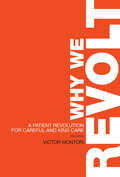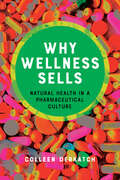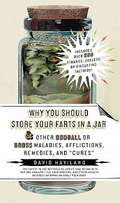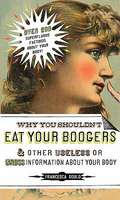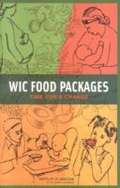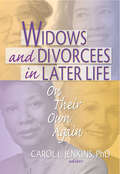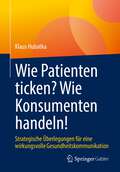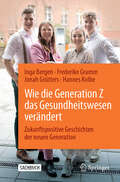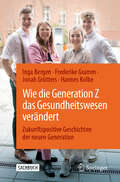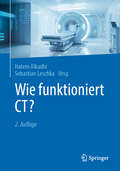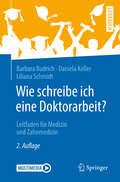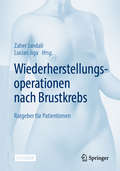- Table View
- List View
Why We Get Sick: The Hidden Epidemic at the Root of Most Chronic Disease--and How to Fight It
by Benjamin BikmanA scientist reveals the groundbreaking evidence linking many major diseases, including cancer, diabetes, and Alzheimer's disease, to a common root cause—insulin resistance—and shares an easy, effective plan to reverse and prevent it. We are sick. Around the world, we struggle with diseases that were once considered rare. Cancer, heart disease, Alzheimer's disease, and diabetes affect millions each year; many people are also struggling with hypertension, weight gain, fatty liver, dementia, low testosterone, menstrual irregularities and infertility, and more. We treat the symptoms, not realizing that all of these diseases and disorders have something in common. Each of them is caused or made worse by a condition known as insulin resistance. And you might have it. Odds are you do—over half of all adults in the United States are insulin resistant, with most other countries either worse or not far behind. In Why We Get Sick, internationally renowned scientist and pathophysiology professor Benjamin Bikman explores why insulin resistance has become so prevalent and why it matters. Unless we recognize it and take steps to reverse the trend, major chronic diseases will be even more widespread. But reversing insulin resistance is possible, and Bikman offers an evidence-based plan to stop and prevent it, with helpful food lists, meal suggestions, easy exercise principles, and more. Full of surprising research and practical advice, Why We Get Sick will help you to take control of your health.
Why We Revolt: A Patient Revolution for Careful and Kind Care
by Victor MontoriThe Mayo Clinic physician and founder of The Patient Revolution offers a &“thoroughly convincing. . . call to action for medical industry reform&” (Kirkus). Winner of the 2018 PenCraft Award for Literary Excellence, Why We Revolt exposes the corruption and negligence that are endemic in America&’s healthcare system—and offers a blueprint for revolutionizing patient care across the country. Through a series of essays and first-hand accounts, Dr. Victor M. Montori demonstrates how the system has been increasingly exploited and industrialized, putting profit before patients. As costs soar, the United States continues to fall behind other countries on patient outcomes. Offering concrete, direct actions we can take to bring positive change to the healthcare system, Why We Revolt is an inspiring call-to-action for physicians, policymakers, and patients alike. Dr. Montori shows how we can work together to create a system that offers tailored healthcare in a kind and careful way. All proceeds from Why We Revolt go directly to Patient Revolution, a non-profit organization founded by Dr. Montori that empowers patients, caregivers, community advocates, and clinicians to rebuild our healthcare system.
Why We Snap
by Douglas FieldsThe startling new science behind sudden acts of violence and the nine triggers this groundbreaking researcher has uncoveredWe all have a rage circuit we can't fully control once it is engaged as R. Douglas Fields, PhD, reveals in this essential book for our time. The daily headlines are filled with examples of otherwise rational people with no history of violence or mental illness suddenly snapping in a domestic dispute, an altercation with police, or road rage attack. We all wish to believe that we are in control of our actions, but the fact is, in certain circumstances we are not. The sad truth is that the right trigger in the right circumstance can unleash a fit of rage in almost anyone. But there is a twist: Essentially the same pathway in the brain that can result in a violent outburst can also enable us to act heroically and altruistically before our conscious brain knows what we are doing. Think of the stranger who dives into a frigid winter lake to save a drowning child.Dr. Fields is an internationally recognized neurobiologist and authority on the brain and the cellular mechanisms of memory. He has spent years trying to understand the biological basis of rage and anomalous violence, and he has concluded that our culture's understanding of the problem is based on an erroneous assumption: that rage attacks are the product of morally or mentally defective individuals, rather than a capacity that we all possess. Fields shows that violent behavior is the result of the clash between our evolutionary hardwiring and triggers in our contemporary world. Our personal space is more crowded than ever, we get less sleep, and we just aren't as fit as our ancestors. We need to understand how the hardwiring works and how to recognize the nine triggers. With a totally new perspective, engaging narrative, and practical advice, Why We Snap uncovers the biological roots of the rage response and how we can protect ourselves--and others.From the Hardcover edition.
Why Wellness Sells: Natural Health in a Pharmaceutical Culture (Health Communication)
by Colleen DerkatchHow and why the idea of wellness holds such rhetorical—and harmful—power.In Why Wellness Sells, Colleen Derkatch examines why the concept of wellness holds such rhetorical power in contemporary culture. Public interest in wellness is driven by two opposing philosophies of health that cycle into and amplify each other: restoration, where people use natural health products to restore themselves to prior states of wellness; and enhancement, where people strive for maximum wellness by optimizing their body's systems and functions. Why Wellness Sells tracks the tension between these two ideas of wellness across a variety of sources, including interviews, popular and social media, advertising, and online activism. Derkatch examines how wellness manifests across multiple domains, where being "well" means different things, ranging from a state of pre-illness to an empowered act of good consumer-citizenship, from physical or moral purification to sustenance and care, and from harm reduction to optimization. Along the way, Derkatch demonstrates that the idea of wellness may promise access to the good life, but it serves primarily as a strategy for coping with a devastating and overwhelming present.Drawing on scholarship in the rhetoric of health and medicine, the health and medical humanities, and related fields, Derkatch offers a nuanced account of how language, belief, behavior, experience, and persuasion collide to produce and promote wellness, one of the most compelling—and harmful—concepts that govern contemporary Western life. She explains that wellness has become so pervasive in the United States and Canada because it is an ever-moving, and thus unachievable, goal. The concept of wellness entrenches an individualist model of health as a personal responsibility, when collectivist approaches would more readily serve the health and well-being of whole populations.
Why You Eat What You Eat: The Science Behind Our Relationship With Food
by Rachel HerzAn eye-opening exploration of the psychology of eating in today’s unprecedented North American pantry of abundance, access, and excess. In Why You Eat What You Eat, acclaimed neuroscientist Rachel Herz examines the sensory, psychological, neuroscientific, and physiological factors that influence our eating habits. Herz, who’s been praised for her “ability to cite and explain academic studies in a conversational manner” (Washington Post), uncovers the fascinating and surprising facts that influence food consumption—such as why bringing reusable bags to the grocery store encourages us to buy more treats, how our beliefs can affect how many calories we burn, why TV influences how much we eat, and how what we see and hear changes how food tastes—and reveals useful techniques for improving our experience of food, such as how aromas can help curb cravings and tips on how to resist repeated trips to the buffet table. Why You Eat What You Eat presents our relationship to food as a complicated recipe, whose ingredients—taste, personality, and emotions—combine to make eating a potent and pleasurable experience. Herz weaves curious findings and compelling facts into a narrative that tackles important questions, revealing how psychology, neurology, and physiology shape our relationship with food, and how food alters the relationship we have with ourselves and each other.
Why You Should Store your Farts Jar Other Oddball or Gross Maladies Afflictions
by David HavilandThe next book in the strange and fascinating series that began with the national bestseller Why You Shouldn't Eat Your Boogers & Other Useless or Gross Information About Your Body. The national bestseller Why You Shouldn't Eat Your Boogers & Other Useless or Gross Information About Your Body uncovered everything one might want to know (and a few things one might not) about the human body. The follow-up bestseller Why Fish Fart & Other Useless or Gross Information About the World contained an artful selection of odd and/or unsavory facts about the world. Why Dogs Eat Poop scoured the animal kingdom for gross and or off-color facts about animals. In this delightfully disgusting new book in the series, David Haviland plumbs the world of medicine to uncover the answers to such vitally important questions as: *What exactly is urine therapy? *Is it safe to fly with breast implants? *How did a nine-and-a-half-inch spatula find its way into a surgery patient's body? *Why do some boxers drink their own pee? *What is cyclic vomiting syndrome and how can one avoid it? Any fan of the absurd and/or obscure is sure to delight in this strange (and slightly stomach-turning) book. .
Why You Shouldn't Eat Your Boogers and Other Useless or Gross Information About Your Body
by Francesca GouldFascinating...Unbelievable...Gross! These are just a few of the responses readers will hear when they impress their friends with facts from the quirky new book of body trivia, Why You Shouldn't Eat Your Boogers & Other Useless or Gross Information About Your Body by Francesca Gould. This collection of little-known facts about the human body answers the questions you have always wanted to ask but never dared to, such as: Can smoking make your teeth fall out? Is it safe to eat moldy food after the mold's been cut off? Do intelligent people have bigger brains? How do astronauts poo in space? The book also offers many unbelievable-but-true historical factoids about the body. For example: Have you ever heard of Dr. Strangelove Syndrome? It's a rare condition caused by damage to certain parts in the brain, which results in a person's hand acting independently and taking on a life of its own. Did you know that there is also a rare condition called Foreign Accent Syndrome, which results in people suddenly developing a foreign accent? Have you ever wondered if a heart transplant could change your personality? The short answer is, yes! Did you know that men used hair gel 2000 years ago during the Iron Age? Why You Shouldn't Eat Your Boogers offers of cornucopia of body trivia that will have readers cringing with delight! You can read it on the subway, in the bathroom, or even in a heavy downpour! For contrary to popular belief, according to this book, you cannot catch cold by standing in the rain!
Why are Some People Healthy and Others Not?: Determinants Of Health Of Populations (Social Institutions And Social Change Ser.)
by Morris L. Barer Theodore R. Marmor Robert G. EvansEach topical chapter in this volume crystallizes the findings of a five-year study, under the auspices of the Population Health Program of the Canadian Institute for Advanced Research, that probed the links between social hierarchy, the -macroenvironmental- factors in illness patterns, the quality of the -microenvironmental, - and other determinants of health. In its aggregate, this volume will prove essential to an understanding of the underlying public health issues for the next several decades.
Why the Dose Matters: Assessing the Health Risk of Exposure to Toxicants
by Urs A. BoelsterliEach day we are exposed to a myriad of natural and human-made chemicals in our food, drinking water, air, soil, at home or at the workplace—pesticide residues, food additives, drugs, household products—but how can we gauge the human health risk posed by these chemicals? Should we believe the somber headlines that depict a serious threat for humans and the environment, or should we follow the reassuring voices of others who claim that the angst is totally unfounded? Why the Dose Matters: Assessing the Health Risk of Exposure to Toxicants uses a rational, science-based approach to explain in plain language that a quantitative view is key for understanding and predicting potentially toxic effects of chemicals. Key Features: Explains the basics of toxicology in easily understandable terms. Includes numerous examples. Clears up common misconceptions and dispels myths. Provides take-home messages for each chapter. This book is aimed at interested laypeople. It uses numerous examples to illustrate the basic concepts and ensure that the reader will get a better understanding of why not only the hazard but also the overall exposure will determine whether some chemicals pose a serious risk while others are of little or negligible concern.
Wi-Fi Enabled Healthcare
by Ali Youssef Douglas McDonald II Jon Linton Bob Zemke Aaron EarleFocusing on the recent proliferation of Wi-Fi in hospital systems, this book explains how Wi-Fi is transforming clinical work flows and infusing new life into the types of mobile devices being implemented in hospitals. Drawing on years of consulting with hospitals in the US and abroad, and with first-hand experiences from one of the largest healthcare systems in the United States, it covers the key areas associated with wireless network design, security, and support. Reporting on cutting-edge developments and emerging standards in Wi-Fi technologies, the book explores security implications for each device type. It covers real-time location services and emerging trends in cloud-based wireless architecture.
Wic Food Packages: Time For A Change
by Institute of Medicine of the National AcademiesThe Special Supplemental Nutrition Program for Women, Infants, and Children (the WIC program) has promoted the health of low-income families for more than 30 years by providing nutrition education, supplemental food, and other valuable services. The program reaches millions of families every year, is one of the largest nutrition programs in the United States, and is an important investment in the nation’s health. The U.S. Department of Agriculture charged the Institute of Medicine with creating a committee to evaluate the WIC food packages (the list of specific foods WIC participants obtain each month). The goal of the study was to improve the quality of the diet of WIC participants while also promoting a healthy body weight that will reduce the risk of chronic diseases. The committee concluded that it is time for a change in the WIC food packages and the book provides details on the proposed new food packages, summarizes how the proposed packages differ from current packages, and discusses the rationale for the proposed packages.
Wichtige Frauen in der Naturheilkunde: Ihr Leben - Ihr Werk - Ihre Schriften
by Annette KerckhoffZiel des Buches ist es, Frauen, die in Europa im 19. und 20. Jahrhundert in der Naturheilkunde tätig waren, endlich sichtbar zu machen. Der Leser erhält Informationen über Lebensweg und Lebensleistung, Heilkunde, Schriften, Bedeutung für heute.Die meisten Frauen, die naturheilkundliche Verfahren anwendeten, wirkten im Stillen und gaben ihr Wissen mündlich weiter. Einige Frauen jedoch entwickelten Heilmittel oder Rezepturen, Diagnose- oder Therapiemethoden, waren in der Forschung tätig, gründeten Einrichtungen, hielten Vorträge oder verfassten Gesundheitsratgeber und andere Schriften. Zu ihnen zählen u.a. Johanna Budwig, Renate Collier, Anna Fischer-Dückelmann, Ida Hofmann, Amalie Hohenester, Emma Kunz, Magdalene Madaus, Margarete Retterspitz, Maria Schlenz, Maria Treben, Katharina Vanselow-Leisen.Ein wertvolles Nachschlagewerk für alle, die an Naturheilkunde und an Frauen in der Heilkunde interessiert sind!
Widows and Divorcees in Later Life: On Their Own Again
by Carol L JenkinsGet a fresh perspective on how older women adapt to life without a spouse! Widows and Divorcees in Later Life: On Their Own Again examines new perspectives on the problems older women face adjusting to life without a spouse. The book examines the transition from the togetherness of marriage to the solitude of being suddenly single, exploring how older widows and divorcees adapt. A multidisciplinary panel of practitioners, researchers, and academics addresses the challenges facing elderly women after a divorce or the death of a spouse, including issues of physical and psychological well-being (clinical depression, nutrition), economics (reduced Social Security benefits, loss of pension income, health care costs), social support (public policy, counseling), and living arrangements. Widows and Divorcees in Later Life: On Their Own Again presents fresh insights into the challenges single women face as they age, including disability and chronic health problems, threats to economic security, and the need for assistance with normal activities of daily living. The book examines the increased hospitalization risk for widowed older women, the protective efforts of social contacts, the impact of minority group status on projected retirement income, care arrangement choices, coping with bereavement, and the changing balance between co-residence with families and institutional care. Interviews, data projections, and research studies offer particular focus on women of Mexican-American and African-American descent, and women living in England and Wales, Africa, and the north and south Pacific. Widows and Divorcees in Later Life: On Their Own Again addresses: the importance of family support the importance of religion and spirituality in coping with loss maintaining social connections maintaining independence the baby boom cohort and much more! Widows and Divorcees in Later Life: On Their Own Again is an insightful examination of the concerns, issues, and problems facing older women who live without a spouse but within specific social and cultural networks from which they receive support.
Wie Patienten ticken? Wie Konsumenten handeln!: Strategische Überlegungen für eine wirkungsvolle Gesundheitskommunikation
by Klaus HubatkaSind Patienten inzwischen Konsumenten? Dieser Frage mit ihren Konsequenzen für die Gesundheitskommunikation geht dieses Fachbuch nach. Einleitend wird das aktuelle Konsumverhalten – als nicht rational handelnder Mensch – allgemein analysiert. Es folgt eine Analyse des Marktes im Gesundheitsbereich und seiner weiteren Entwicklung im Vergleich zum allgemeinen Markt, um entsprechende Analogien festzustellen. Nach einer Darstellung der in den letzten Jahren sich verändernden Patientenrolle werden die empirischen Ergebnisse des neuen Patientenverhaltens – auf Basis von Forschungsarbeiten des Autors – präsentiert. Im Rahmen einer analytischen Betrachtung der Patienten als Konsumenten werden die konkreten Veränderungen aufgezeigt und im Konsum-Modell schlüssig erläutert. Daraus ableitend werden neue wirkungsorientierte Ansätze für Aktionen und Interventionen im Gesundheitsbereich vorgestellt und Ausblicke in die Zukunft eines Gesundheitsmarktes gegeben, in dem der selbstbestimmte Patient als internationaler Konsument agiert. Dieses Buch ist wegweisend für alle, die Konzepte für eine zukunftsorientierte Gesundheitskommunikation entwickeln und umsetzen wollen. Besondere Bedeutung erhalten die behandelten Themen durch die aktuelle gesellschaftliche Relevanz von Gesundheitsvorsorge, Prävention und konkret auch von Impfverhalten (von Konsumenten).
Wie Wissenschaft Länder, Gesellschaften, Religionen vereint: Ein Überblick für Wissenschaftler und Politiker (essentials)
by Heiko HerwaldUnsere heutige Welt ist geprägt von einer rasanten technologischen Entwicklung. Die daraus resultierende digitale Reizüberflutung, das unermessliche Sammeln von Daten und die Entwicklung von Algorithmen, die für uns jetzt schon Entscheidungen übernehmen, haben das Wertesystem der Menschen verändert. Anhand des Höhlengleichnisses von Platon beschreibt der Autor, wieso der Mensch seine Unabhängigkeit aufgibt und er sich von einem Homo sapiens zu einem Homo accumulans (speichernder Mensch) entwickelt hat. Er zeigt auf, warum Paradigmenwechsel in Religion, Politik und Wissenschaft für die Weiterentwicklung der Menschheit von großer Bedeutung waren und wieso dies für die Wissenschaft auch weiterhin notwendig sein wird, um Lösungen für globale Probleme zu entwickeln.
Wie bitte?: Kommunikation in Gesundheitsberufen (Top im Gesundheitsjob)
by Renate TewesMiteinander reden hilft! Dieses Buch hilft Mitarbeitende im Gesundheitswesen Kolleg*Innen und Patient*Innen besser zu verstehen. Verschaffen Sie sich einen Überblick über die Vielfalt praktikabler Kommunikationsmodelle und nutzen Sie die Erfolgspotenziale gelungener Kommunikation. Die 3. Auflage ist komplett aktualisiert und enthält nun ein extra Kapitel mit sämtlichen Kommunikationsmethoden. Egal ob Sie im Notfall Rücksprache halten, jemanden überzeugen müssen, ein Risiko einschätzen wollen oder unangenehme Nachrichten übermitteln möchten: für all diese Situationen gibt es praktikable Modelle, die uns den Alltag erleichtern. Basics einer guten Kommunikation für Team und Patienten Lösungsansätze bei Fehlinformationen und schlechtem Arbeitsklima Mit zahlreichen Beispielen, Übungen und Techniken
Wie die Generation Z das Gesundheitswesen verändert: Zukunftspositive Geschichten der neuen Generation
by Inga Bergen Frederike Gramm Jonah Grütters Hannes KolbeWillkommen in der Welt der GenZ – eine Generation, die das Gesundheitswesen neu definiert. In dem Sammelband Wie die Generation Z das Gesundheitswesen verändert: Zukunftspositive Geschichten der neuen Generation teilen junge Autor*innen ihre Visionen und Erfahrungen, die das traditionelle Verständnis von Medizin und Gesundheitsmanagement herausfordern. Aufgewachsen in einer Zeit rasanter digitaler und demografischer Veränderungen, bieten diese Autor*innen frische Perspektiven auf Medizin und Gesundheitsmanagement. Sie hinterfragen etablierte Praktiken, fordern digitale Optimierung und setzen sich für mehr Vielfalt und Innovation im Gesundheitswesen ein. Von den Herausforderungen im Klinikalltag bis hin zu den Erwartungen junger Patient*innen – dieses Buch beleuchtet, wie die GenZ das Gesundheitswesen neugestaltet. Mit Beiträgen von jungen Talenten und etablierten Fachleuten bietet, Wie die Generation Z das Gesundheitswesen verändert einen umfassenden Einblick in aktuelle und zukünftige Trends im Gesundheitswesen. Es ist eine unverzichtbare Lektüre für alle, die an den Schnittstellen von Generationenwandel, technologischer Innovation und Gesundheitsversorgung interessiert sind.
Wie die Generation Z das Gesundheitswesen verändert: Zukunftspositive Geschichten der neuen Generation
by Inga Bergen Frederike Gramm Jonah Grütters Hannes KolbeWillkommen in der Welt der GenZ – eine Generation, die das Gesundheitswesen neu definiert. In dem Sammelband Wie die Generation Z das Gesundheitswesen verändert: Zukunftspositive Geschichten der neuen Generation teilen junge Autor*innen ihre Visionen und Erfahrungen, die das traditionelle Verständnis von Medizin und Gesundheitsmanagement herausfordern. Aufgewachsen in einer Zeit rasanter digitaler und demografischer Veränderungen, bieten diese Autor*innen frische Perspektiven auf Medizin und Gesundheitsmanagement. Sie hinterfragen etablierte Praktiken, fordern digitale Optimierung und setzen sich für mehr Vielfalt und Innovation im Gesundheitswesen ein. Von den Herausforderungen im Klinikalltag bis hin zu den Erwartungen junger Patient*innen – dieses Buch beleuchtet, wie die GenZ das Gesundheitswesen neugestaltet. Mit Beiträgen von jungen Talenten und etablierten Fachleuten bietet, Wie die Generation Z das Gesundheitswesen verändert einen umfassenden Einblick in aktuelle und zukünftige Trends im Gesundheitswesen. Es ist eine unverzichtbare Lektüre für alle, die an den Schnittstellen von Generationenwandel, technologischer Innovation und Gesundheitsversorgung interessiert sind.
Wie funktioniert CT?
by Hatem Alkadhi Sebastian LeschkaWie funktioniert eigentlich die CT?Dieses Buch beantwortet, leicht und verständlich erklärt, diese Frage zur Computertomographie. Das Autorenteam hat sein Wissen vom Aufbau, von der Funktionsweise und von den spezifischen Anwendungen dieser faszinierenden bildgebenden Methode in diesem Buch zusammengefasst und dabei die 2. Auflage substantiell erweitert. Sowohl angehende Radiologen als auch Radiologie-Assistenten und MTRA/RTA finden hier den perfekten Überblick zur Computertomographie.Aus dem Inhalt:Von den technischen Grundlagen wie Röhrendesign oder Prinzipien der Bilderzeugung über die grundsätzliche praktische Anwendung, hier erfahren die Leser grundlegende Kniffe, wie man mit der CT arbeitet.Neu wird in der zweiten, vollständig überarbeiteten und aktualisierten Auflage auch das Photon-Counting CT erklärt, von technischen Besonderheiten bis hin zu klinischen Anwendungen.Von erfahrenen Kursleitern geschrieben, legt dasBuch besonderen Wert auf eine leicht verständliche und anwendbare Darstellung. Didaktisch ausgefeilte Grafiken und Tabellen veranschaulichen die Informationen und helfen beim Verständnis schwierigerer Sachverhalte.Übersichtstabellen und viele Tipps und Tricks zur Erzielung optimaler Ergebnisse bei den verschiedenen Fragestellungen machen das Buch darüber hinaus im täglichen Arbeitsalltag auch für Fortgeschrittene interessant. Wie funktioniert CT? - Hier finden Sie die Antwort!
Wie funktioniert MRI?: Eine Einführung in Physik und Funktionsweise der Magnetresonanzbildgebung
by Dominik Weishaupt Victor D. Köchli Borut MarincekWie funktioniert MRI? - Genau so!Physik und Funktionsweise der Magnetresonanztomographie sind komplex und für den Nicht-Physiker nur schwierig nachzuvollziehen. Dennoch muss jeder, der diese Technik in der Praxis erfolgreich anwenden möchte, ihre Grundlagen verstehen.In diesem Buch wird das erforderliche physikalische und technische Basiswissen prägnant und bestechend anschaulich erklärt. Dieses Konzept war bereits in 6 Auflagen außerordentlich erfolgreich und wird in der Neuauflage fortgeführt.Sämtliche Kapitel wurden aktualisiert. Dem immer mehr an Bedeutung gewinnenden Thema "Diffusionsbildgebung" wird durch ein neues Kapitel Rechnung getragen. Ein ausführliches Glossar dient dem schnellen Nachschlagen und Lernen von Fachbegriffen.Das Buch ist ein Muss für alle Ärzte, MTRAs und Studenten, die sich mit den Grundlagen der MRT vertraut machen wollen.
Wie man lebt, so stirbt man: Vom Leben und Sterben großer Psychotherapeuten
by Werner GrossDieses Sachbuch widmet sich dem großen Thema Leben und Sterben auf besondere Art: Es stellt Gründer von Psychotherapieschulen in den Mittelpunkt und erzählt über ihren Lebensstil, ihren Sterbensstil und ihr Wirken. Wie haben sie gelebt, durch welche Irrungen und Wirrungen sind sie im Laufe ihres Lebens gegangen, welche Krisen haben sie durchlebt und wie haben sie diese bestanden? Welche Folgerungen haben sie daraus gezogen? Und schließlich: Wie sind sie gestorben? Unterhaltsam und gut lesbar erschließt sich: Ihre Haltung zu Leben und Sterben hat einen Einfluss auf die Entwicklung der jeweiligen Psychotherapie-Methode. Geschrieben für interessierte Laien, Psychotherapeuten in Praxis und Ausbildung, Psychiater, Berater. Aus dem Inhalt: Freud, Jung, Adler, Moreno, Perls, Reich, von Dürckheim, Peseschkian – ihr Blick auf Leben und Sterben und die Bedeutung für ihre Psychotherapieschule. Über den Autor: Werner Gross, Dipl.-Psych., Psychotherapeut, Supervisor und Coach, Organisations- und Unternehmensberater.
Wie sage ich meinem Kind, dass ich Krebs habe?: Ratgeber für Eltern
by Bianca SenfErkrankt ein Elternteil an Krebs, sind auch die Kinder mitbetroffen. Dieser Ratgeber ist aus der konkreten Beratungspraxis entstanden und beantwortet die häufigsten Fragen, die Eltern mit einer Krebsdiagnose belasten.Warum hat mir denn keiner etwas gesagt, fragen Kinder oft noch Jahre nach der Erkrankung, denn viele Kinder und Jugendliche entwickeln im Verlauf der elterlichen Krebserkrankung starke Stress-Symptome bis hin zu psychologischen Störungen wie Angsterkrankung, Belastungsstörungen, Zwangserkrankungen oder Depressionen.Die Autorin gibt Tipps für verschiedene Situationen anhand konkreter Beispiele und macht Vorschläge für eine gute und gelungene Kommunikation. Sie ermutigt dazu, Kinder frühzeitig alters- und kindgerecht (vom Kleinkind bis zum Jugendlichen) in diese wichtige Veränderung in der Familie einzubeziehen, damit sie gestärkt und gereift aus der Situation herausgehen können.
Wie schreibe ich eine Doktorarbeit?: Leitfaden für Medizin und Zahnmedizin (Springer-Lehrbuch)
by Barbara Budrich Daniela Keller Liliana SchmidtVon der Vorbereitung bis zum gelungenen Abschluss Dieser Leitfaden vermittelt klar und schnell, wie man systematisch und praxisorientiert eine erfolgreiche Doktorarbeit in der Medizin oder Zahnmedizin anfertigt. Zahlreiche praxiserprobte Strategien und Methoden helfen bei der Umsetzung. Das Buch bietet zahlreiche Anregungen zur Motivation und Hilfe bei verschiedenen Herausforderungen der Doktorarbeit.
Wie wollen wir leben?: Über unsere Zukunft entscheiden wir selbst
by Gerhard GründerStellen Sie sich auch die Frage, wie stark Ihr Denken, Ihr Fühlen und Ihr Verhalten durch Ihre Gene und Ihre Biologie bestimmt sind? Haben Sie Zweifel daran, dass der Eingriff in unsere Hirnchemie uns zu glücklicheren und zufriedeneren Menschen macht? Sind Sie skeptisch, dass Computeralgorithmen Ihr Wesen als Mensch erfassen können?Dieses Sachbuch stellt das Weltbild des „göttlichen Menschen“ (Harari), in dem der Mensch durch seine Biologie determiniert ist und die Medizin zu seiner Optimierung dient, infrage. Der Autor zeigt, dass wir die aktiven Gestalter unserer Lebensbedingungen sind und damit über die eigene physische und psychische Gesundheit bestimmen.Lassen Sie sich anregen zur Mitarbeit bei der Gestaltung der Zukunft einer menschlichen Gesellschaft, in der wir zu entscheiden haben, wo wir leben, wie wir miteinander leben, wie wir arbeiten und wie wir uns bilden. Zielgruppen:Ideal für alle, die sich für die Grundlagen von Hirnforschung, Psychologie und Psychiatrie interessieren und die sich Gedanken über das Wesen des Menschen und dessen Zukunft machen.Zum Autor: Prof. Dr. Gerhard Gründer, Psychiater und Psychotherapeut, ist Professor an der Universität Heidelberg. Er leitet die Abteilung für Molekulares Neuroimaging am Zentralinstitut für Seelische Gesundheit in Mannheim.
Wiederherstellungsoperationen nach Brustkrebs: Ratgeber für Patientinnen
by Zaher Jandali Lucian JigaMit der Diagnose Brustkrebs entsteht bei vielen Frauen auch gleichzeitig die Angst vor der Entstellung des eigenen Körpers. Auch wenn die Krebstherapie selbstverständlich an erster Stelle steht, gewinnt die Thematik der Brustwiederherstellung immer mehr an Bedeutung. Dieses Buch soll betroffenen Frauen die gängigsten Methoden der Brustwiederherstellung aufzeigen Aus langjähriger Erfahrung der Autoren wird dabei der klassische Ablauf einer Wiederherstellung von Brustvolumen, Brustwarze und Angleichung der Gegenseite vorgestellt. Die Herausgeber legen neben der Brustwiederherstellung mit Silikonimplantaten ein besonderes Augenmerk auf die modernen Methoden der Rekonstruktion mit Eigengewebe. Hierzu gehören unter anderem die Eigenfetttransplantation, die Gewebeverlagerungen von Bauch, Rücken, Gesäß sowie Flanken und Oberschenkeln. Die einzelnen Methoden werden systematisch aufgearbeitet, deren Vorteile aufgezeigt und die Nachteile kritisch diskutiert. Schritt für Schritt werden die einzelnen Operationsschritte erläutert und die jeweilige Vor- und Nachbehandlung genauestens besprochen. Am Ende einer jeden Methode erwartet den Leser ein Fazit der Herausgeber. Ein eigenes Kapitel wird abschließend der Erkrankung des Lymphödems nach Lymphknotenentfernung bei Brustkrebserkrankten gewidmet. Neben der konservativen Behandlung werden insbesondere moderne Methoden der Mikrochirurgie erläutert. „Wir hoffen mit diesem Ratgeber betroffenen Frauen verständliche Informationen zum Thema Brustwiederherstellung geben zu können und ihnen ihre Entscheidungen im Rahmen der Behandlung zu vereinfachen“ Dr. med. Zaher Jandali

